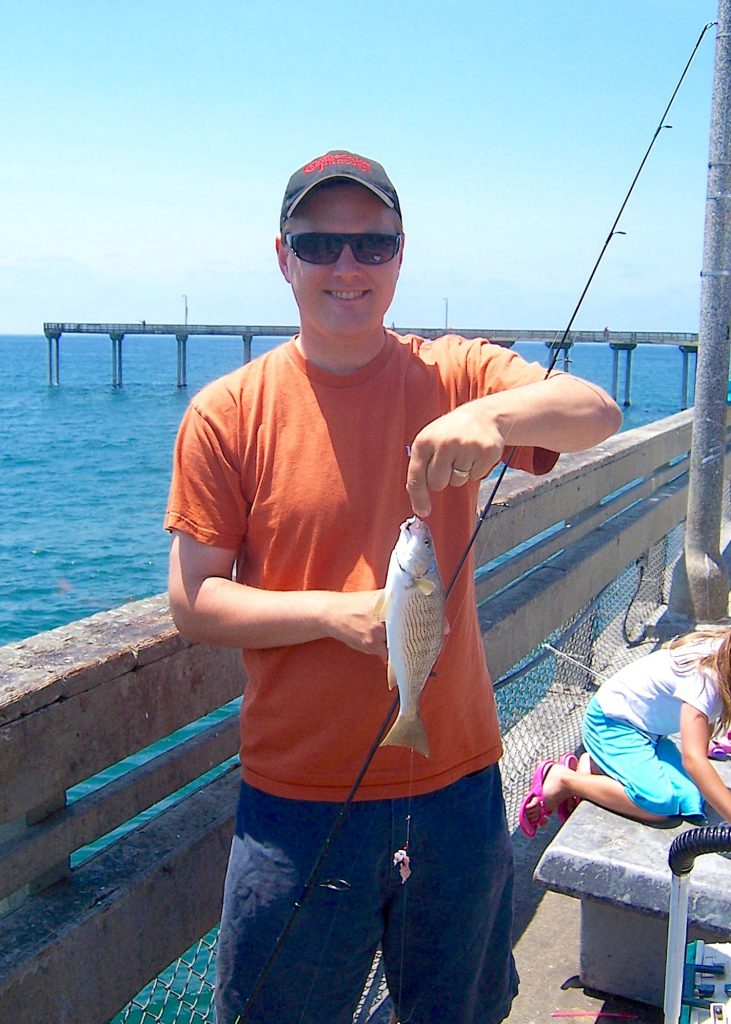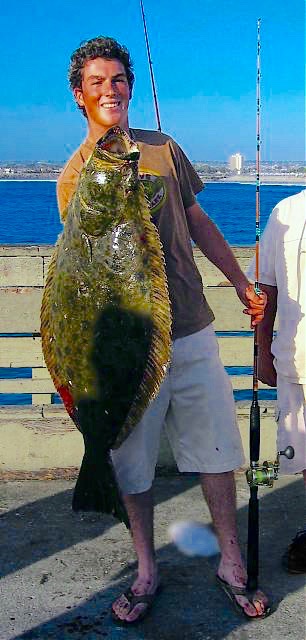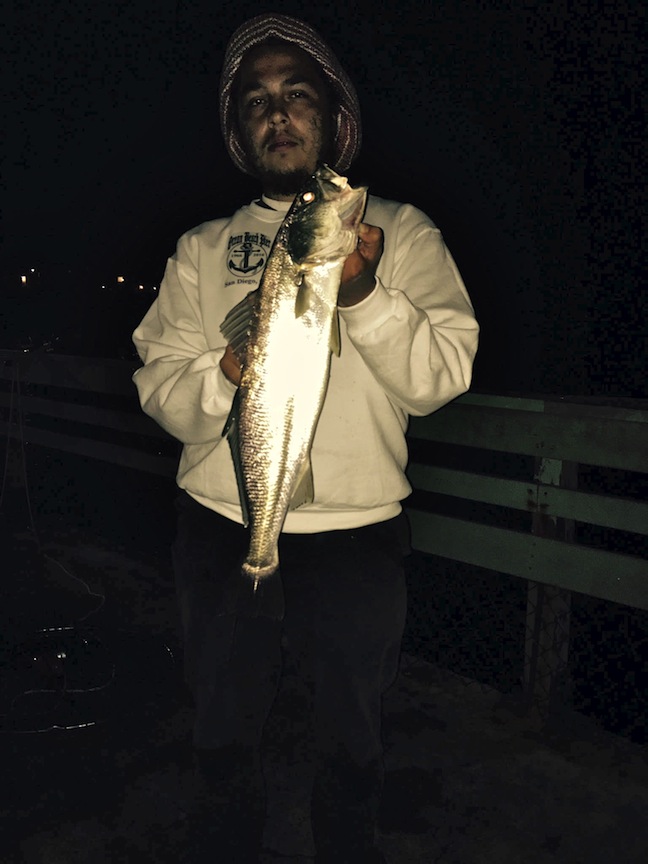Fishing Areas
Successful pier fisherman study and know that most piers have several distinct areas: inshore, mid-pier, far end, and piling area. Each offer up somewhat different species (with some overlap) and each can call for different baits and techniques.
• Inshore, shallow water area, tideline out a short distance.
Unlike most piers, the shoreline here sees two distinct environments and the shallow water angler is given two choices.
Fishing the northern side, the sandy shore beach area presents the normal SoCal surf species—surfperch (mainly barred and walleye), corbina, and both yellowfin and spotfin croaker. A few sharks (gray smoothhound and leopard) and rays (primarily round stingrays and thornbacks) round out the action. Use high/low riggings or a Carolina rigging with size 6 or 4 hooks, and sand crabs, fresh mussels, or sea worms (bloodworms or lugworms) as bait for the perch and croakers. For the sharays, use the same rigging but larger size 4-2/0 hooks, and oily/smelly fish (pieces of mackerel, sardines, or anchovies).
Fishing the southern, rocky shore beach area one is presented an entirely different environment. Anglers can see species like opaleye, halfmoon, blackperch, rubberlip seaperch, blacksmith, senorita and kelpfish. However, it’s not an easy fishery. Due to the direction of the waves and the cut of the shoreline, water depth here is typically less than that on the north side. Thus the water for the most part is only fishable during high tide, low breaker conditions. If the tide is strong and waves are big it can be hard to hold bottom effectively (and larger sinkers simply means more money lost when the sinker grabs a rock on the bottom).
For the most part it’s a fishery perhaps best left to the regulars who know what they are doing. However, if you do decide to give it a try, successful anglers usually use fresh mussels or seaworms for bait and keep the hooks small, usually size 6 or 8. For the opaleye, and they can reach a good size, try using frozen peas that have been allowed to thaw; place just enough peas on the hook to cover the hook.
During low tides it is a fun area to take the kids to check out the tide pools in the area (just be careful, the rocks can be very slippery).
• Inner mid-pier area — due to its length we’ll divide up the mid-pier area into two distinct areas. The inner section is the realm of halibut and other species.

As the water deepens, there will be a change in species (to some degree). The inshore perch and croaker remain but they will be joined by additional members of their perch (Embiotocidae) and croaker (Sciaeidae) families. Ditto the sharays, the inshore varieties (thornback rays, leopard sharks and gray smoothhound sharks) can still be caught but they will be joined by more shovelnose sharks (guitarfish), bat rays, and even a few butterfly rays. All can be taken on the same set ups and bait as mentioned for the leopard sharks.
A short way out on the pier, just past the breaker area, and where the pier surface ends its descent and begins to level off, is a large, green colored wire cage. This area, primarily on the north side, seems to yield a lot of leopard sharks, some of which have been pretty decent in size (up to about five feet bin length). For the leopards fish on the bottom with either high/low rigging or Carolina rigging, use size 2-2/0 hooks, and squid, mackerel, or similar strong flavored (and smelling) bait.
Continued action can be had on the yellowfin and spotfin croaker with the yellowfin dominating this somewhat deeper water. They will be joined, generally at night, by black croaker and the croaker look-a-like sargo. All will fall for mussels (especially fresh mussels), bloodworms, lugworms, ghost shrimp, and pieces of market shrimp or razor clams fished on the bottom.
They can be joined by their small croaker relatives the white croaker (aka tomcod or kingfish) and queenfish (aka herring). The white croaker will hit the same baits but also small pieces of anchovy or mackerel; use size 6 or 4 hooks. They will often hit a bait as soon as it hits the bottom after a cast and if not hooked will follow a bait slowly reeled back to the pier. Often they will make a final attack on the bait just as it is being pulled up from the bottom.
The queenfish prefer to hang in schools under the pier and are ideally suited for Sabikis or simply small bare hooks placed on a line and jigged slowly up and down. Drop a line to the bottom with small pieces of bait and bring it back to the top after stopping every couple of feet to see if there is a bite. If a school is there, and you find the right depth the school is at, you can catch many fish.

Halibut are generally the most prized fish and are especially prevalent in the mid-pier area. The halibut, being ambush predators, prefer live bait fished on the bottom, i.e., a small smelt, mackerel, shinerperch, or small white croaker and queenfish (both collectively known as brown bait). They also will hit a moving lure. Many artificial lures will work with proven lures including Big Hammers, AA sized Cotee Lures (white and blue, white and green, clear silver and blue, or clear silver and green), pearl white-colored Zoom Flukes (or white-colored Berkley Gulp Jerk Shads), and Berkley Power Sand Worms with a drop shot rig. If seeking halibut when using live bait or artificial lures, use a Carolina-rigging and size 4-2 hooks. Using this rig, a fish does not feel a weight and is more likely to take the bait and hook. Simply take an egg sinker (that has a hole through the middle of it) and run your line through the sinker. Next, tie a snap-swivel to the end of your line (after adding a couple of red beads above the snap-swivel to help attract fish and protect the knot from abrasion). Next attach the leader (usually 24-36 inches in length) to the snap, add the bait or lure and be ready to cast. I prefer to use Fluorocarbon leaders. In addition, if using live bait you might want to hook the bait under the bait near the back (given the halibut swim up and ambush the bait from below).
Do remember that the halibut like to lie in the troughs between the pilings waiting for a baitfish to make an appearance. In response, many halibut anglers like to troll their bait or lures between those pilings. Just keep a careful watch on your line.

Jacksmelt and topsmelt can also begin to show in good numbers. These feisty little fish, actually silversides and not true smelt, usually hit at mid-depths or near the top and will hit a variety of baits depending, evidently, upon their mood. Sea worms, small pieces of shrimp, pieces of anchovy or mackerel, and even strips of squid will take the gamey little fighters but sometimes it seems their preference for food can change from day to day. Most anglers seeking the jacksmelt will use a float of some type to keep the bait just under the surface, everything from big bobbers, to pieces of Styrofoam and balloons. Many will use Sabiki bait rigs for the fish but I’ve always preferred keeping it simple with my typical high/low rigging and size 8 or 6 hooks fished under the float. Small lures like Roostertails can also attract the jacksmelt and can provide a fun fight on light tackle.
Pelagics such as Pacific mackerel and jack mackerel also can be found here but usually are more common farther out on the pier.
Outer mid-pier area — the area from about a hundred yards inshore of the restaurant to just past the restaurant.
Quite often you will find this area loaded with anglers, especially just inshore, on the north side, from the tackle shop/restaurant/restroom area. Many are whole families primarily fishing for small queenfish (called herring) and they will fill buckets with the small but tasty fish. There is not a limit on the fish and it’s a good thing for them because at times they will have hundreds of fish. The queenfish usually school in the mid-depth area, often half way from the top and bottom, and most are caught by jigging, either a casual up and down motion with small baits or baited (or plain) Sabiki-type bait rigs.
Small white croaker (called tomcod) are also sometimes common in this area but are found on the bottom instead of mid-depth. Use a high/low rigging with size 6 or 4 hooks baited with small pieces of anchovy, mackerel or strips of squid. As mentioned, they will often follow a sinker and bait down from when it enters the water and make a hit as soon as the bait reaches the bottom. If not hooked, begin an immediate slow retrieve and they will often follow the bait almost to the surface sometimes hitting it just before it leaves the water. If not hooked just repeat the procedure.
Given the amount of food in the mid-pier waters (especially the sometimes immense schools of very small smelt), it’s not surprising that this area is another primo area for halibut (although the pier is not really a noted halibut pier). May through September are normally the best months and most of the flatties are taken on live bait (anchovy, queenfish, white croaker, small smelt, small walleye surfperch, etc.).
One tip is to remember that the halibut will often lay in the depressions between the pilings while eyeing the schools of queenfish and other small fish up above. Catch the baitfish with multi-hook bait rig leaders (size 6 or 8), or make your own snag line (tie 3-4 small hooks directly to your line, about four inches apart). Fish the snag line unbaited, or sweeten it with a small strip of anchovy (or a very small live pinhead anchovy or smelt). Most of the halibut are under the 22-inch minimum size but not all, large halibut are caught every year.
Artificial lures, most often swimbaits, can also attract the prized fish. Halibut are ambush predators and the flatfish will lie on the bottom waiting for a fish (or fish imitating lure) to pass overhead. When it sees a likely victim it will lunge and grab the fish/lure so be prepared for the strike.
A lot of shovelnose guitarfish and bat rays will also be hanging out in these waters feeding on the queenfish (and a 57-pound shovelnose was reported in July of ‘99). It was in this area that I once caught a nearly 4-foot-wide California butterfly ray. Another day I got an uncommon, just barely 6-inch-long, deepbody anchovy (Anchoa compressa) that hit rig intended for mackerel. I believe there is a reef on the north side of the pier in this area, and that may explain why the majority of the fish seem to be taken on that side.
Some years will also see fairly good runs of sargo in this area; try a high/low rigging baited with ghost shrimp, bloodworms, fresh mussels or pieces of shrimp.
Given the attraction of the queenfish and white croaker as baitfish (they are often called brown bait) you might also see a couple of the larger pelagic, open ocean, game fish—white seabass and Pacific barracuda. Unfortunately, most will be under the 28-inch minimum length needed to make them legal size. The best bait on the white seabass (usually juvenile “sea trout” with stripes) is, no surprise, a small queenfish and the prime time is May-June. Most of the barracuda on the other hand are taken on artificial lures such as Krocodile and Kastmaster spoons and most are taken at night during the late summer or fall months.